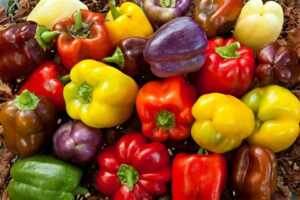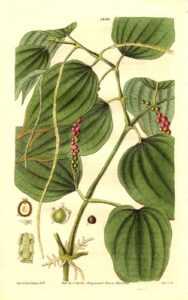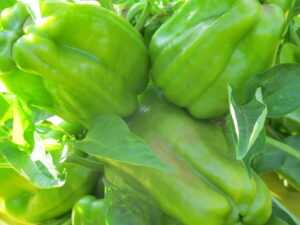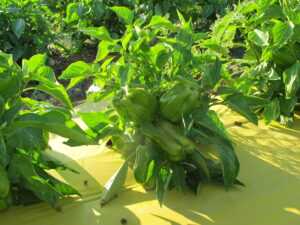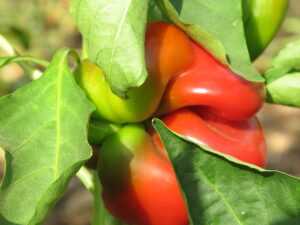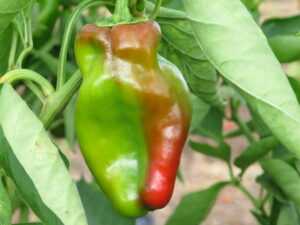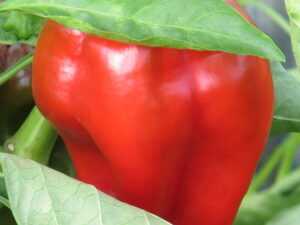One hot summer day this week, I started thinking about summer. With so many folks out gallivanting the globe, the thought struck me that there are so many components of your summer boxes which started out around the globe as well, including from the uncharted territories of Africa and America before they were “discovered” in the 15th century. Take tomatoes, squash, pumpkins, corn, potatoes, peppers and sweet potatoes, for example – not one of these tasty vegetables appeared in the European vegetable garden or the Israeli one before the discovery of America. Okra, garlic and watermelon were born in Africa and immigrated here many years ago. The thought of a life bereft of the redness of tomatoes, the green of corn sheaves, the orange of pumpkins and sweet potatoes or the juiciness of watermelon brings to mind black and white TV. One can learn a lesson of modesty from the vegetable patch (usually a good idea): to enjoy the wealth of a colorful, bountiful summer season and to understand a few things about the wonder of difference and varieties, and the great profit and joy to be gained by allowing this variety to develop and reproduce.
(Check out this very interesting article from Masa Acher (Hebrew) about the global culinary migration.)
One of these migrants from the American continent is the pepper, which takes a starring role in your boxes these days. The honorable pepper has now come for a long visit, scheduled to stay all the way till autumn.
The pepper we know and eat in its sweet or spicy varieties, in red, yellow, green or orange (also available in purple, black and brown…) actually received its name by mistake. The word “pepper” originally referred to the pepper spice (i.e. black or white pepper), and only later was lent to the chili and green pepper vegetables.
The black pepper spice (a member of the Piperaceae family, whose black, green or pink seeds—at various stages in the maturation—produce the savory black and white ground pepper condiment we know and love) originated in India, with its name derived from the Sanskrit “Pipali.” Europe was already well-acquainted with pepper, as well as its relative, the Piper longum, which was also used as a very piquant spice. The name was translated via commerce into the Latin “Piper,” from there to the old English “Pipor,” German “Pfeffer,” French “poivre,” Dutch “peper,” and other languages. At the same time, the word was translated from Sanskrit to Persian to Aramaic, becoming known by the ancient Jewish sages. In Mishnaic Hebrew, it in known as “Pilpelin” or “pilpelet,” and in Talmudic “Pilpula.” Its spicy flavor became synonymous with a quick tongue and a sharp brain (thus, in Hebrew, a Talmudic – or other – discussion is termed hitpalpalut), and to describe vigorous diligence.
Pepper spice plant
When Christopher Columbus attempted to discover a shortcut to the Indian spice route, he was unruffled by the fact that he found something totally different. He bestowed the spicy vegetable he met in the Caribbean (from the Solanaceae family) the same name as the fiery Indian spice he had met, thus confusing the world forever after. There is absolutely no botanical connection between the two plants. Yet the American pepper was as spicy as the Indian one, and Columbus, a merchant and sophisticated marketing man hoping to sell it for a pretty penny in his mother continent, gave them the same name. In his journal, Columbus noted that “the pepper which the local Indians used as spice is more abundant and more valuable than either black or melegueta pepper.” His enthusiasm helped the spicy vegetable travel via Spanish and Portuguese maritime routes to Europe, Africa, Southeast Asia and India, and of course, to Hungary, where the ground dried pepper became the national spice, aka paprika.
Soon enough, it was discovered that this spicy vegetable has a sweet little sibling (actually a bunch of sweet siblings), but the name was already given and would not be changed. So, these were coined “sweet peppers,” in Hebrew “gamba.”
In Central America, the vegetable has a long and ancient history. Petrified peppers have been found in archeological digs in Central America dating back over 2000 years, and they appear in Peruvian embroidery relics from the first century. The Olmecs, Toltecins and Aztecs were only some of the cultures known to raise peppers and use them in culinary endeavors. Together with the spicy pepper types, the sweet varieties were brought to Europe. By the beginning of the 17th century, the Europeans discovered the rich variety of the peppers we know today, all raised and grown over the years by habitants of Central America.
Today there are hundreds of pepper varieties which span the taste bud gamut from sweet, bittersweet, spicy to sweet-and-spicy, etc. There are also a host of shapes: large and elongated; square and bell-shaped, hence the name “bell pepper;” small, long and heart-shaped like the Spanish pimiento pepper; long and yellow like a banana, or tiny, like those used for pickling; long and narrow, small and triangular, thin as a shoelace, and more. The colors also vary: they come in green, the original pepper shade, and then range in hue from light to dark green, but that’s not all. When I worked in California, we grew a pepper that started out purple on the outside and green on the inside! As it ripens, the pepper changes shades, similar to the process the tomato undergoes where the level of sugar (or spiciness) is raised and it turns a warmer hue. The most popular peppers are the yellow, orange, and of course, red, but they also come in black and maroon! The sweet pepper and the spicy peppers are harvested at different stages of their growth – from the green to red stage, thus we get to enjoy a wide range of flavors and color.
Planting peppers was actually the first time Alon and I worked together, when he joined me in spring 2004. We planted them in a totally open field, but today the first crops at the beginning of spring are well-groomed in the pampering planting tunnel, with mesh net walls surrounding them for protection, a shade net above and trellising strings that help them stay erect to climb up and away. And like well-pampered, beloved children, they produce great yields totally worth all the trouble of raising them. However, we also grow them in the open field. The summer plants sometimes suffer in the planting tunnel, thus we prefer to plant them in the more ventilated open field. Don’t worry, we pamper them, too, by planting every pepper bed between two Thai lubia beds which climb up the trellising nets on both its sides. We then spread a shade net from one end to the other, as preventative medicine against possible diseases lurking and/or exposure to sunstroke.
Sometimes we begin harvesting the peppers when they are still young and green. The pepper harvest is in fact a simultaneous harvest and thinning out. As we harvest the green peppers, we pick from the denser parts of the bush to allow breathing space and growing room for the remaining vegetables. Upon ripening, the green peppers start turning red, first one cheek, then the other, and slowly become completely blanketed under a red cover. This process takes about three weeks. Now when we harvest peppers, we choose only the ones that are almost entirely red. At the end of the harvest there are still green and half-red peppers awaiting full blush, preparing for next harvest.
Over the past few years, we try to ease some of the plant’s burden in its first stages of growth. To allow for it to invest in its growth (to help it grow taller and yield vegetables over a longer period of time), we thin out the plant at the flowering stage, similar to thinning when growing fruit on trees, allowing those that remain on the plant to develop in a thinner, more spacious environment. Thus, our first harvests are usually red peppers, which ripened on the plant for a longer period of uncrowded time.
Last year, we decided to expand our pepper crop beyond just sweet peppers and made a first attempt at growing spicy peppers of the “Lapid” variety. Inspired by our Thai employees who have been cultivating small super spicy pepper bushes for years, we ventured (mildly) into that world. The variety we grow is not too spicy nor too small, and very delicious! You are welcome to add it to your boxes via the Chubeza online order system under “Additional Products”. Take a look at this gorgeous little fella.
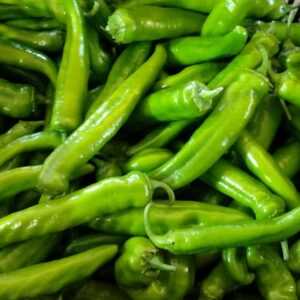
All peppers are very rich in Vitamin C, making them natural anti-aging agents and beneficial in preventing heart and vascular diseases and certain cancers. Vitamin C is important for proper immune system function, and augments iron absorption through the intestines. Another important pepper component is Vitamin A, an anti-oxidant which protects body tissues and cells tissues from oxidation. Vitamin A also aids in the prevention of cancer, heart and vascular diseases, and promotes anti-aging. Vitamin A is crucial for night vision and vital for the proper functioning of the immune system, cells, tissue, mucosal tissues and skin.
May we enjoy a quiet week, where the only excitement comes from summer and fun,
Alon, Bat Ami, Dror, Orin and the Chubeza team
__________________________________________
WHAT’S IN THIS WEEK’S BOXES?
Monday: Bell peppers/Amoro pumpkin/slice of pumpkin, Thai yard-long beans (lubia)/or Iraqi short lubia, parsley/coriander, sweet potatoes, cucumbers, tomatoes, onions/scallions, lettuce, butternut squash/acorn squash, eggplant [regular or Baladi or Japanese fingers], corn.
Large box, in addition: Okra, cherry tomatoes, green soybeans (adamame).
FRUIT BOXES: Pears/long plums, nectarines, apples, mango. Large boxes: Greater quantities of all the fruits above + Blueberries.
Wednesday: Bell peppers, Thai yard-long beans (lubia), parsley/coriander, sweet potatoes, cucumbers, tomatoes, onions/scallions, lettuce, eggplant [regular or Baladi or Japanese fingers] / Amoro pumpkin, cherry tomatoes, corn.
Large box, in addition: Okra/slice of pumpkin, butternut squash, green soybeans (adamame).
FRUIT BOXES: Pears/long plums, nectarines, apples, mango. Large boxes: Greater quantities of all the fruits above + Blueberries.

